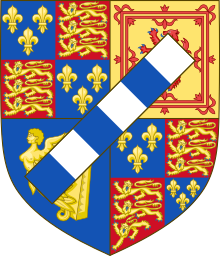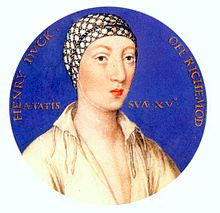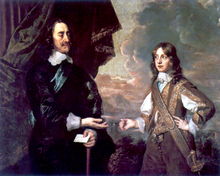
The House of Stuart, originally spelled Stewart, was a royal house of Scotland, England, Ireland and later Great Britain. The family name comes from the office of High Steward of Scotland, which had been held by the family progenitor Walter fitz Alan. The name Stewart and variations had become established as a family name by the time of his grandson Walter Stewart. The first monarch of the Stewart line was Robert II, whose male-line descendants were kings and queens in Scotland from 1371, and of England, Ireland and Great Britain from 1603, until 1714. Mary, Queen of Scots (r.1542-1567), was brought up in France where she adopted the French spelling of the name Stuart.

Henry FitzRoy, 1st Duke of Grafton, was an illegitimate son of King Charles II of England and his mistress Barbara Villiers. A military commander, Henry FitzRoy was appointed colonel of the Grenadier Guards in 1681 and Vice-Admiral of England from 1682 to 1689. He was killed in the storming of Cork during the Williamite–Jacobite War in 1690.

Barbara Palmer, 1st Duchess of Cleveland, Countess of Castlemaine, was an English royal mistress of the Villiers family and perhaps the most notorious of the many mistresses of King Charles II of England, by whom she had five children, all of them acknowledged and subsequently ennobled. Barbara was the subject of many portraits, in particular by court painter Sir Peter Lely.

Eleanor Gwyn was an English stage actress and celebrity figure of the Restoration period. Praised by Samuel Pepys for her comic performances as one of the first actresses on the English stage, she became best known for being a long-time mistress of King Charles II of England.

Elizabeth Blount, commonly known during her lifetime as Bessie Blount, was a mistress of Henry VIII of England.

Henry FitzRoy, Duke of Richmond and Somerset was the son of Henry VIII of England and his mistress Elizabeth Blount, and the only child born out of wedlock whom Henry acknowledged. He was the younger half-brother of Mary I, as well as the older half-brother of Elizabeth I and Edward VI. Through his mother, he was the elder half-brother of Elizabeth, George, and Robert Tailboys. His surname means "son of the king" in Norman French.

Charles Lennox, 1st Duke of Richmond, 1st Duke of Lennox, of Goodwood House near Chichester in Sussex, was the youngest of the seven illegitimate sons of King Charles II, and was that king's only son by his French-born mistress Louise de Kérouaille, Duchess of Portsmouth. He was appointed Hereditary Constable of Inverness Castle.

Louis III de Bourbon, Prince of Condé was a prince du sang as a member of the reigning House of Bourbon at the French court of Louis XIV. Styled as Duke of Bourbon from birth, he succeeded his father in 1709 as Prince of Condé ; however, he was still known by the ducal title. He was prince for less than a year.

Charles FitzRoy, 2nd Duke of Grafton, was a British peer and politician.
Fitzroy or FitzRoy may refer to:

Charles Beauclerk, 1st Duke of St. Albans, KG was an illegitimate son of King Charles II of England by his mistress Nell Gwyn.

Charles Beauclerk, 2nd Duke of St Albans, KG KB was a British politician who sat in the House of Commons from 1718 until 1726 when he succeeded to a peerage as Duke of St Albans. He was an illegitimate grandson of King Charles II.

César de Bourbon, Légitimé de France was the illegitimate son of Henry IV of France and his mistress Gabrielle d'Estrées, and founder of the House of Bourbon-Vendome. He held the titles of 1st Duke of Vendôme, 2nd Duke of Beaufort and 2nd Duke of Étampes, but is also simply known as César de Vendôme.

Louis-Auguste de Bourbon, duc du Maine was an illegitimate son of Louis XIV and his official mistress, Madame de Montespan. The king's favourite son, he was the founder of the semi-royal House of Bourbon-Maine named after his title and his surname.
Fitz was a patronymic indicator used in Anglo-Norman England to help distinguish individuals by identifying their immediate predecessors. Meaning "son of", it would precede the father's forename, or less commonly a title held by the father. In rare cases, it formed part of a matronymic to associate the bearer with a more prominent mother. Convention among modern historians is to represent the word as fitz, but in the original Norman French documentation, it appears as fiz, filz, or similar forms, deriving from the Old French noun filz, fiz, meaning "son of", and ultimately from Latin filius (son). Its use during the period of English surname adoption led to its incorporation into patronymic surnames, and at later periods this form was adopted by English kings for the surnames given some of their recognized illegitimate children, and by Irish families when anglicizing their Gaelic patronymic surnames.
Bourbon-Vendôme refers to two branches of the House of Bourbon, the first of which became the senior legitimate line of the House of Bourbon in 1527, and succeeded to the throne of France in 1589 with Henry IV. He created the second house by granting the dukedom of Vendôme to one his legitimized sons.

A prince du sang is a person legitimately descended in male line from a sovereign. The female equivalent is princess of the blood, being applied to the daughter of a prince of the blood. The most prominent examples include members of the French royal line, but the term prince of the blood has been used in other families more generally, for example among the British royal family and when referring to the Shinnōke in Japan.

Louis de Bourbon, Légitimé de France, Count of Vermandois, born Louis de La Blaume Le Blanc, also known as Louis de/of Vermandois was a French nobleman, illegitimate but legitimised son of Louis XIV, King of France by his mistress, Louise de La Vallière. He died exiled and disgraced at the age of 16, unmarried and without issue.

Sophia Sidney, Baroness De L'Isle and Dudley was the eldest illegitimate daughter of William IV of the United Kingdom and his longtime mistress Dorothea Jordan. She was married to Philip Sidney, 1st Baron De L'Isle and Dudley, and had four surviving children. Shortly before her death in 1837, she served as State Housekeeper in Kensington Palace.
The House of Stuart is a noble family of Scottish origin that eventually became monarchs of Scotland, England, Ireland, and Great Britain.



















